The Ultimate Top Trumps Game of Legendary Blades

Legendary swords have captured the human imagination for centuries. The world of mythical blades and enigmatic weaponry is a realm where history, legend, and intrigue intertwine to create stories that endure through time.
In this blog post, we explore the fascination and allure of 18 extraordinary swords from the European sword Excalibur, the fabled sword of King Arthur, to Chinese swords like Guandao and Green Dragon Crescent Blade, wielded by Guan Yu, to unveil the ultimate ranking of the biggest sword mysteries.
But that’s not all. We’re thrilled to introduce an exciting element to this exploration: our very own Sword Mysteries Top Trumps game.
As you read on, you’ll discover the Top Trumps scores for each of the featured swords, based on a set of intriguing criteria, from deadliness to discoverability.
The Top 5 Greatest Sword Mysteries
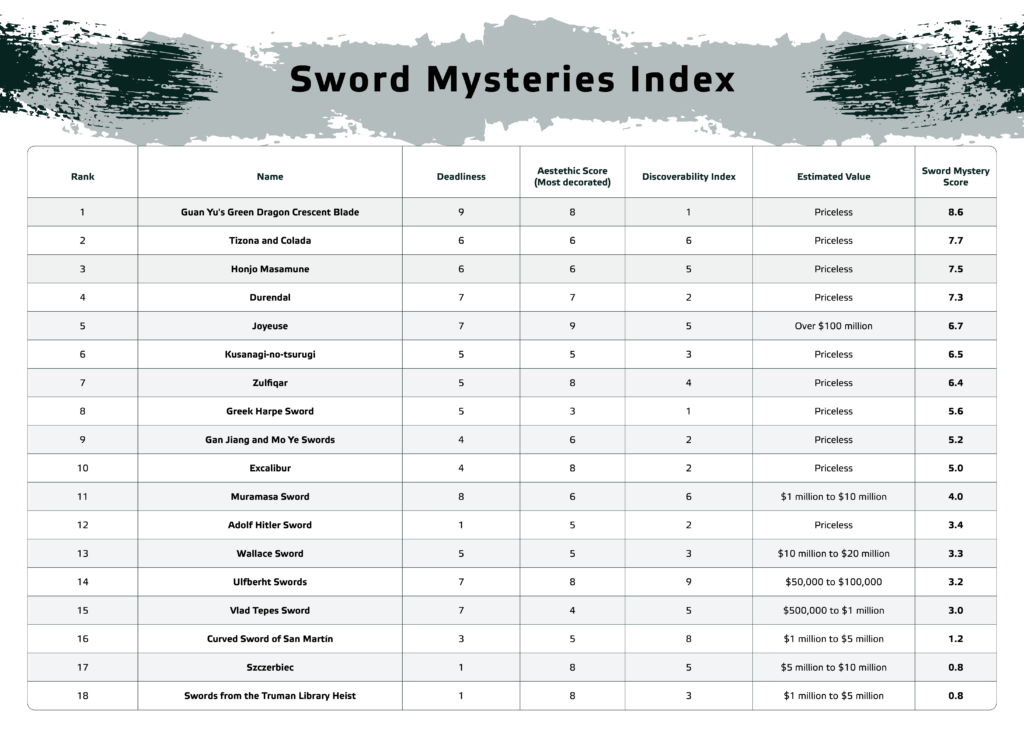
1. Guan Yu’s Green Dragon Crescent Blade
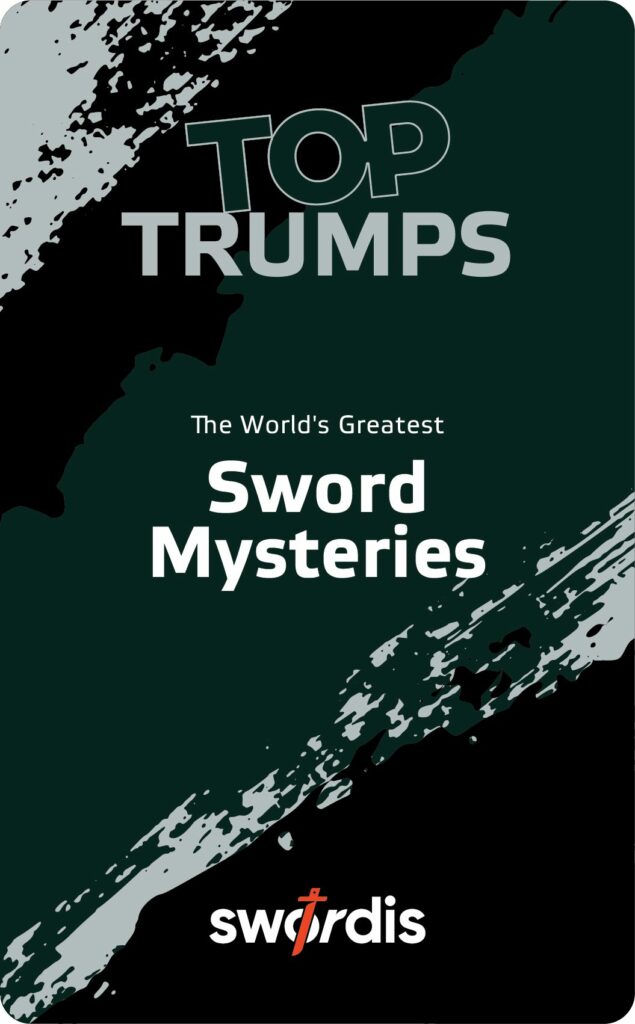
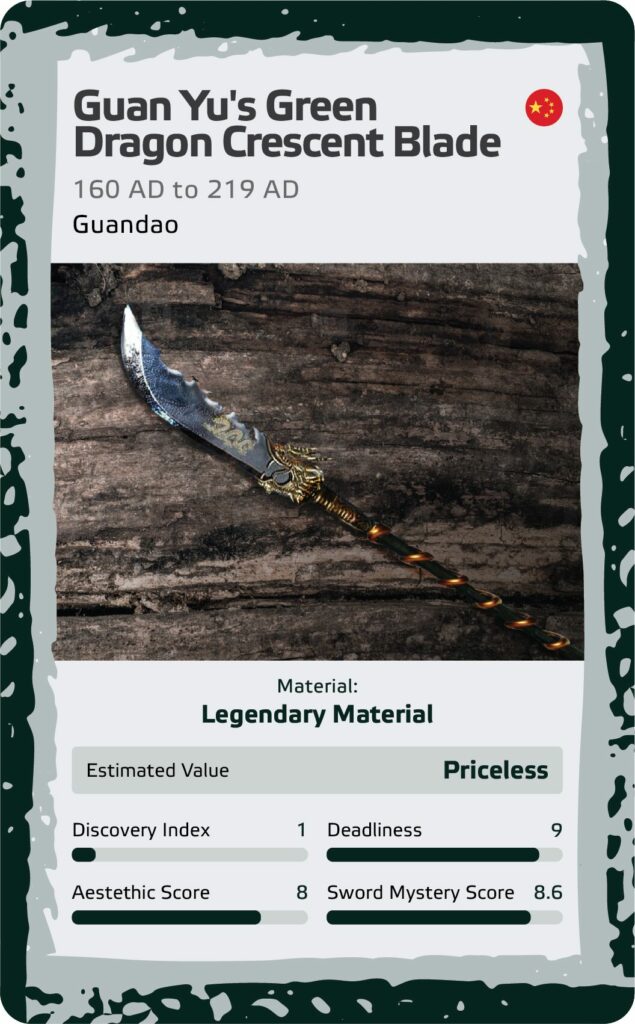

In the tapestry of Chinese history, the figure of Guan Yu stands as a colossus, and his weapon, the Green Dragon Crescent Blade, is equally legendary. Hailing from the tumultuous Three Kingdoms period, Guan Yu’s historicity intertwines with myth, making the origins of his colossal guandao shrouded in mystery. The blade, said to have been forged with the miraculous contribution of 1780 drops of blood from the Chinese Emerald Dragon, carries a mystique that transcends the boundaries of reality.
The Green Dragon Crescent Blade, wielded by Guan Yu, earns a deadliness score of 9 due to its pivotal role in the Three Kingdoms battles and its formidable crescent-shaped blade adorned with flame-like hooks. With an aesthetics score of 8, the guandao merges functionality with artistry, boasting intricate dragon-themed embellishments that reflect the awe-inspiring imagery of Chinese mythology.
However, its discoverability score is a mere 1, rooted in the anachronistic nature of the weapon, casting doubt on its physical existence during Guan Yu’s time. As for its estimated value, the Green Dragon Crescent Blade transcends monetary worth, earning a priceless status tied to the cultural and historical reverence for Guan Yu, symbolizing loyalty, valor, and the enduring legacy of Chinese mythology and martial prowess.
2. Tizona and Colada










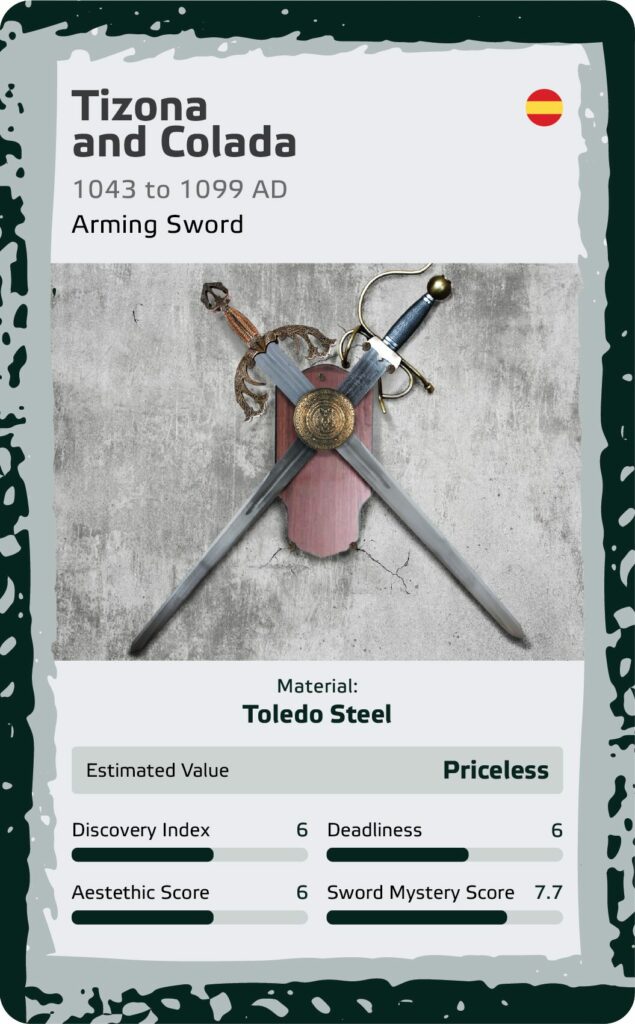

Steeped in the epic narratives of the Spanish Reconquista, Tizona and Colada, the legendary swords of El Cid, evoke tales of valor and the clash between Christians and Moors. As historical fact intertwines with medieval Spanish epic poetry, the swords’ origins and supernatural qualities become subjects of debate and fascination. Tizona and Colada, said to shine brilliantly and possess magical properties, add an air of mystery to the historical legacy of El Cid.
Tizona and Colada achieve a deadliness score of 6, attributed to their association with El Cid and the legendary tales of blinding enemies with their radiant shine. The aesthetics score of 6 reflects the swords’ historical and cultural significance, adorned with Renaissance-styled hilts of Hispanic/Moorish origin. Their discoverability, with a score of 6, is influenced by the ongoing debate over their authenticity, adding an element of uncertainty to their true nature. The estimated value, deemed “priceless,” emphasizes the swords’ cultural and historical importance, representing Spain’s identity during a crucial period in its history.
3. Honjo Masamune










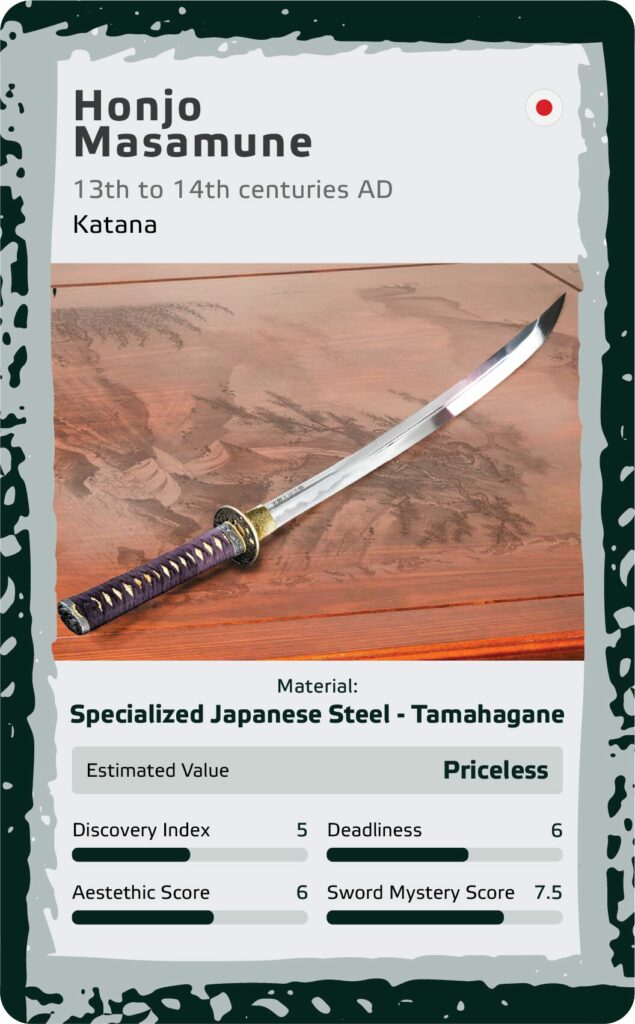

Woven into the fabric of Japanese history and craftsmanship, the Honjo Masamune, a Japanese katana by the revered swordsmith Masamune, bears the weight of national treasure status and the intrigue of a post-World War II disappearance. Its creation date, tentatively set in the late 13th to early 14th century, aligns with an era when Masamune’s masterpieces graced feudal Japan. The disappearance of the Honjo Masamune during the American occupation adds a layer of mystery, elevating its status as a sought-after relic.
The Honjo Masamune attains a deadliness score of 6, rooted in its effectiveness as a practical katana with a combat-oriented design. With an aesthetics score of 6, the katana’s simple elegance, crafted from tamahagane, echoes Masamune’s legendary skill.
The discoverability score of 5 is influenced by the sword’s mysterious disappearance, heightening the quest for its whereabouts. While deemed “priceless” in value, the Honjo Masamune’s true worth lies not just in its craftsmanship but in its enigmatic journey through Japanese history.
4. Durendal










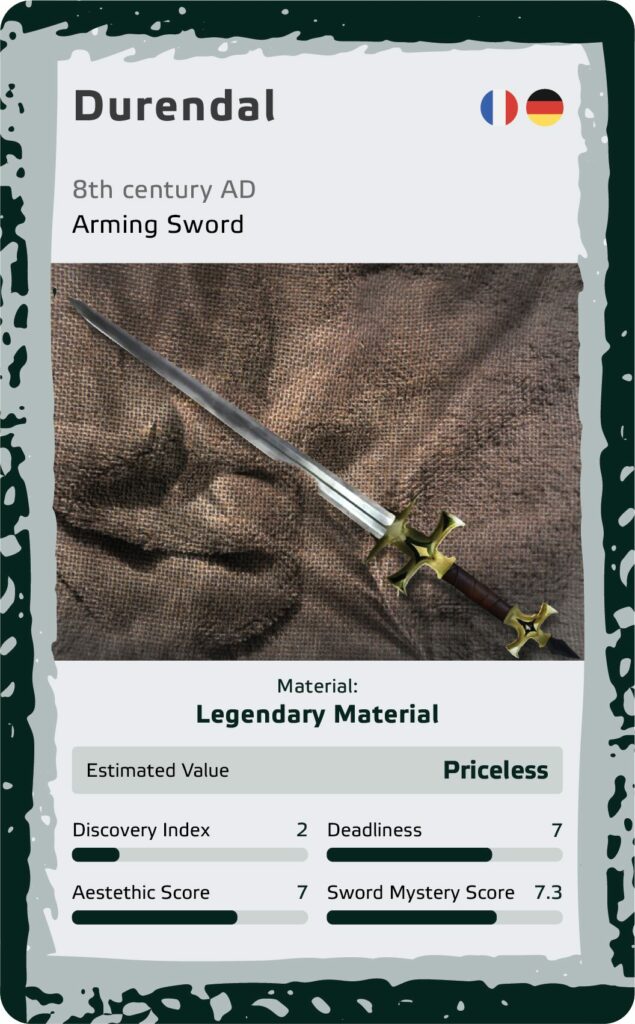

Immersed in the medieval French epic “The Song of Roland,” Durendal, the sword of the valiant paladin Roland, stands as an enduring symbol of resilience and mystery. Forged by the mythical Wayland the Smith, the sword’s unbreakable nature and the circumstances of its concealment beneath Roland’s body after a fierce battle add layers of intrigue to its legacy. Rooted in the Frankish Kingdom during the 8th century, Durendal intertwines myth and history, creating an enigmatic narrative.
Durendal achieves a deadliness score of 7, representing its legendary feats in the epic battles and its unbreakable nature. The aesthetics score of 7 showcases the sword’s intricate gold-plated hilt and polished blade, symbolizing both opulence and battlefield prowess.
With a discoverability score of 2, Durendal’s elusive nature and the blending of fact with myth contribute to its mysterious aura. Valued as “priceless,” the sword’s worth transcends material considerations, embodying cultural and literary significance within the tapestry of the Frankish Kingdom’s history.
5. Joyeuse










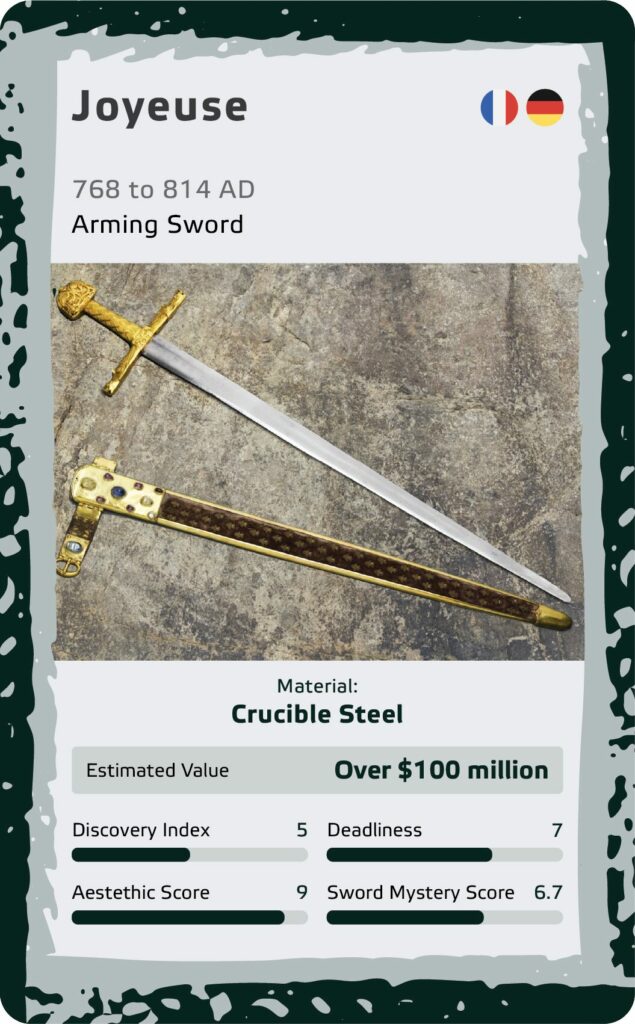

Shrouded in the mist of Charlemagne’s reign, Joyeuse, an arming sword attributed to the legendary emperor, emerges as a testament to the blend of myth and historical debate. The sword’s historical association with Charlemagne, coupled with the mystery surrounding its composition, adds layers of fascination. Displayed in the Louvre Museum, Joyeuse’s value and authenticity have sparked scholarly debates, contributing to its mystique.
Notably, it is crucial to acknowledge that the sword on display is far from the original. The only elements potentially preserved are the scabbard belt and minor parts of the steel. Most other components have undergone multiple remakes and modifications throughout the centuries, further deepening the enigma surrounding Joyeuse.
Joyeuse claims a deadliness score of 7, reflecting its legendary ability to blind enemies and grant magical powers. With an aesthetics score of 9, the sword’s opulent design, including a gold-plated hilt adorned with intricate decorations, mirrors the grandeur of an emperor. The discoverability score of 5 is influenced by ongoing debates over the sword’s authenticity, enhancing its enigmatic aura. Valued at “over $100 million,” Joyeuse’s worth is influenced by its legendary status as the sword of a key figure in European history and its association with otherworldly materials and mystical properties, encapsulating the mythical legacy of Charlemagne and the timeless allure of legendary swords.
Deadliest Swords
Each of the following blades carries a distinctive deadliness score, based on a combination of functional capabilities, physical attributes, and known records of historical battles and rumors of mythical powers. This convergence of history and myth results in a score reflective of their lethal prowess.
1. Guan Yu’s Green Dragon Crescent Blade
Guan Yu’s Green Dragon Crescent Blade, a massive guandao, emerges as a deadly force in the historical battles of China’s Three Kingdoms period. With a deadliness score of 9, this legendary weapon played a pivotal role in the hands of Guan Yu, a revered general. Its crescent-shaped blade, adorned with hooks resembling flames, delivered a fearsome combination of slashing and thrusting capabilities, contributing to multiple casualties on the battlefield. The high deadliness score is rooted in both historical significance and the formidable design of the guandao, amplifying its lethal reputation.
2. Muramasa Sword










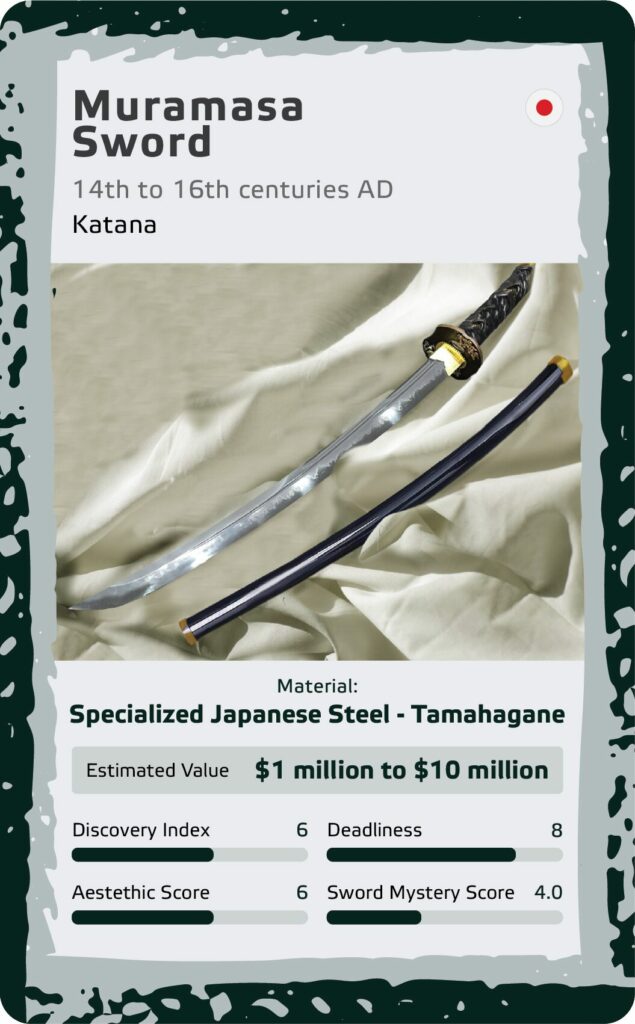

The Muramasa swords, crafted by the legendary Japanese swordsmith Muramasa, are shrouded in a mystique that extends beyond their sharp edges. With a deadliness score of 8, these blades are renowned for their sharpness and have a history of being used in various battles. However, their reputation goes beyond mere functionality, as they are believed to incite bloodlust and misfortune upon their wielders. The deadly nature of Muramasa swords is not only attributed to their physical attributes but also to the purported curse that accompanies them, adding an element of danger to their legacy.
3. Vlad Tepes Sword, Ulfberht, Joyeuse, and Durendal










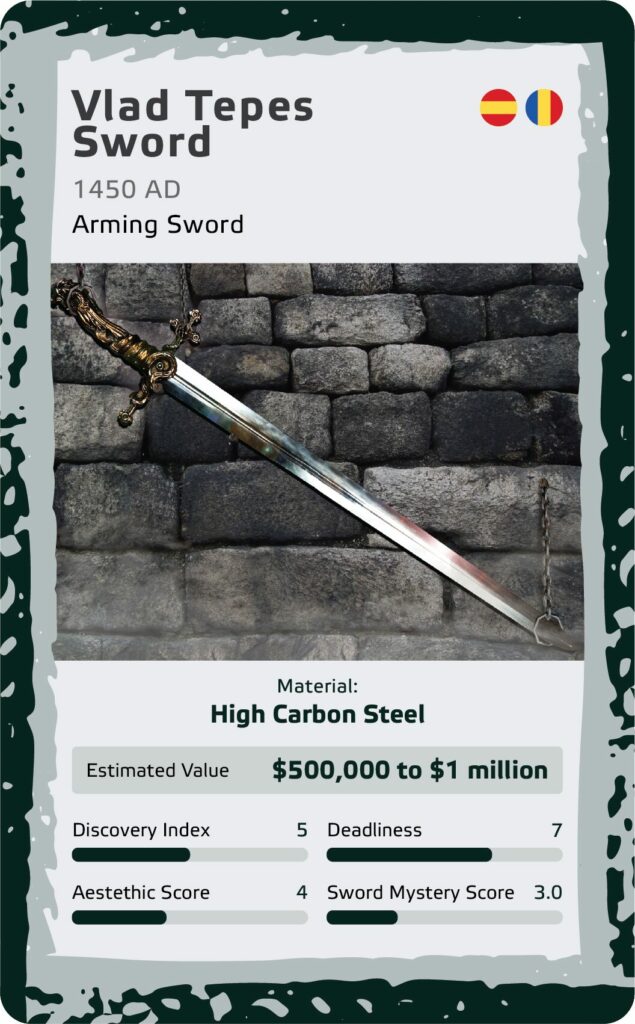

The swords of Vlad Tepes, the Ulfberht, Joyeuse, and Durendal all share a deadliness score of 7, reflecting their potential prowess on the battlefield.
- Vlad Tepes, known for his ruthless methods as the 15th-century ruler of Wallachia, is linked with a sword symbolizing power and cruelty, although specific documentation is lacking.
- The Ulfberht swords, dating from the Viking Age, showcase advanced metallurgy and high-quality crucible steel, contributing to their reputation for deadliness in the hands of Viking warriors.
- Joyeuse, associated with Charlemagne, earns its score through historical significance and mythical attributes, including the ability to blind enemies and grant magical powers.
- Durendal, the legendary sword of Roland, adds to the shared score, with its unbreakable nature and feats in battles contributing to its reputation for deadliness.
Finest Swords
Adorned with opulence, intricate details, and a touch of mystique, the artistic heights achieved by the swordsmith’s craft get a special mention here. The aesthetic score for each of the swords below, representing the most decorated swords, really set these blades apart from the rest.
1. Joyeuse
Joyeuse, earning the highest aesthetic score of 9, stands as an opulent masterpiece befitting an emperor. Crafted from crucible steel, its gold-plated hilt is adorned with intricate decorations and engravings. The renowned blade possesses a bright, reflective effect, sparking legends of its ability to change colors and outshine the sun multiple times a day. The scabbard, gilded with rare stones and pearls, adds to the overall allure, making Joyeuse not just a deadly weapon but a symbol of regal elegance and mythical grandeur.
2. Guan Yu’s Green Dragon Crescent Blade, Zulfiqar, Swords from the Truman Library Heist, Excalibur, Ulfberht Swords, and Szczerbiec
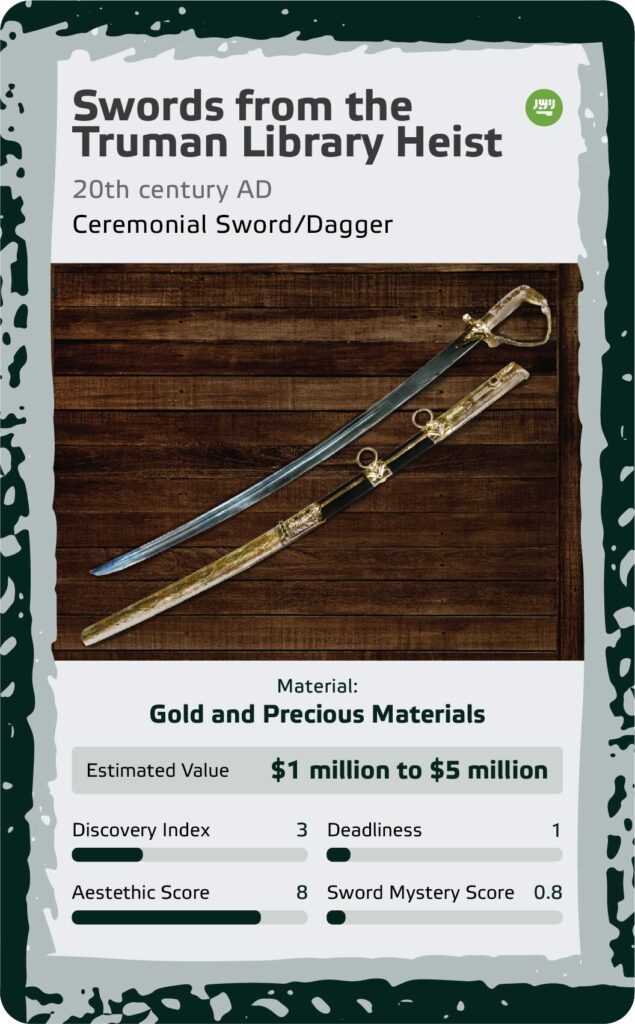



All of these swords share an impressive aesthetic score of 8, showcasing both deadly functionality and artistic brilliance. Guan Yu’s guandao, with its crescent-shaped blade and dragon-themed embellishments, blends functionality with the imagery of Chinese mythology.
- Zulfiqar, associated with Ali ibn Abi Talib, is a richly decorated piece symbolizing cultural and religious significance.
- The swords from the Truman Library Heist, with their elaborate designs incorporating gold, diamonds, jade, and other precious metals, remain both artistically distinctive and culturally valuable.
- Excalibur, the legendary sword of King Arthur, boasts a highly ornate, gold-plated hilt with diverse inscriptions and engravings.
- Ulfberht Swords, known for their advanced metallurgy, feature blades with vibrant layers, making them artistically pleasing and mysterious.
- Szczerbiec, the ceremonial sword of Polish kings, showcases lavishly decorated features with extensive use of gold and precious metals, reflecting Polish tradition and culture.
3. Durendal
Durendal, with a slightly lower aesthetic score of 7, is an arming sword featuring an intricately decorated, gold-plated hilt and a polished, gleaming blade. The dazzling quality of the blade adds to its overall allure, contributing to its aesthetic appeal despite the mystery surrounding its whereabouts. While not reaching the same aesthetic heights as Joyeuse, Durendal’s design and craftsmanship still make it a visually striking piece, merging functionality with artistic elegance.
Worth Searching For
Among the 18 swords, several stand out as particularly worth searching for. These swords present opportunities for exploration, research, and potential discoveries that could enrich our understanding of history, culture, and craftsmanship.
Ulfberht Swords










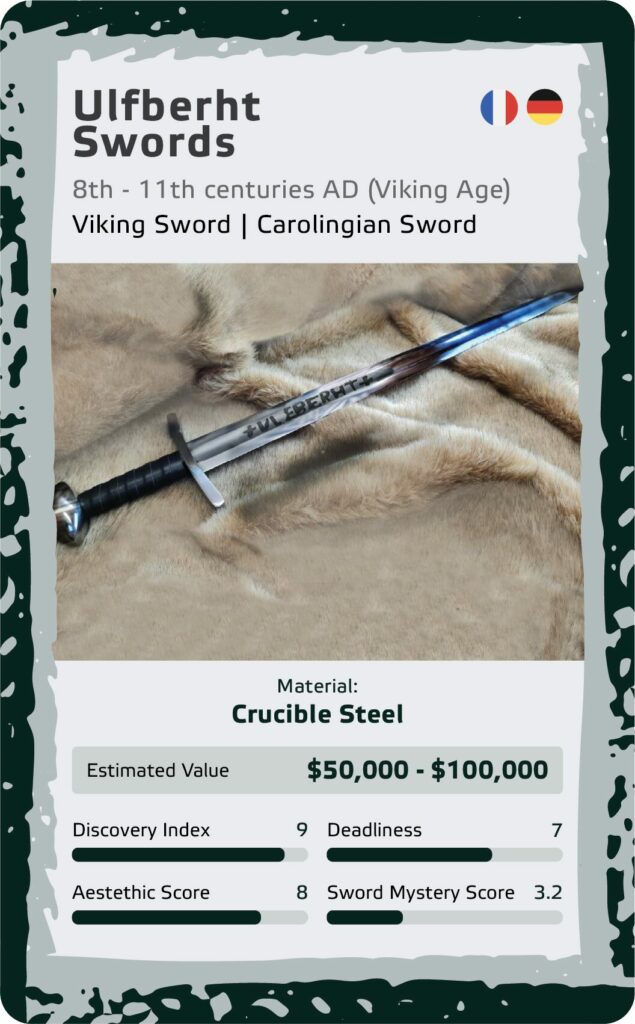

With the highest discovery index score of 9, the Ulfberht swords, dating from the Viking Age, are already known and have been discovered before, with examples found in museums and private collections. However, due to their high value (estimated at $50,000 to $100,000), historical significance, and desirability among collectors, they remain a target for illicit trade. Ongoing research and archaeological efforts to uncover more Ulfberht swords could provide additional insights into Viking craftsmanship and trade networks.
Curved Sword of San Martín










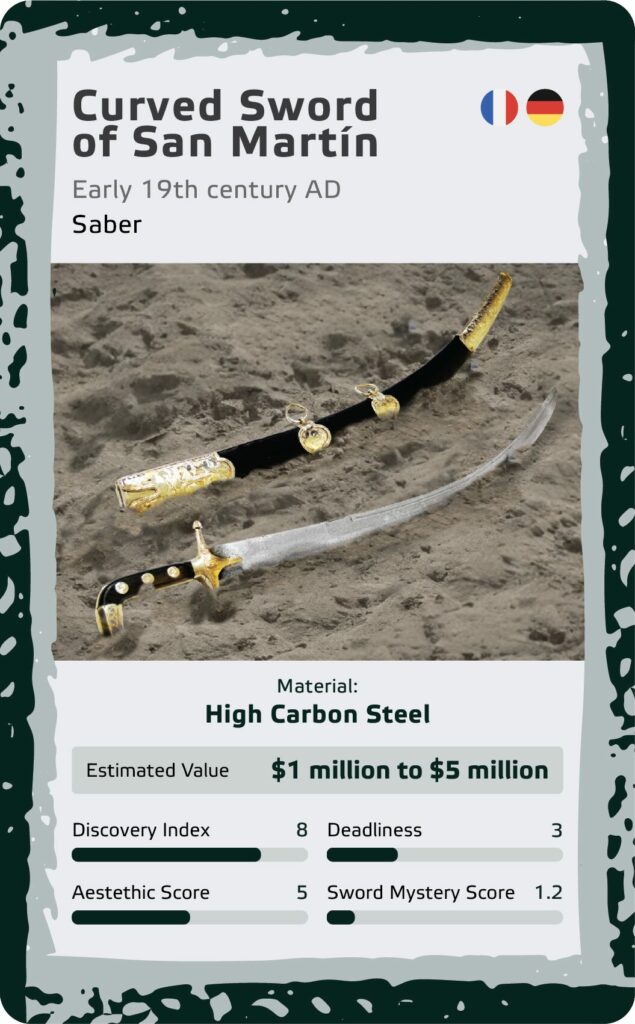

Associated with José de San Martín, a prominent figure in Latin America’s fight for independence, this sword’s location is ambiguous. While there are replicas and claimed originals, the true sword’s resting place remains uncertain. Ongoing investigations, especially in Buenos Aires, could shed light on the authenticity and historical journey of this sword and, with an estimated value of $1 million to $5 million and a discovery index score of 8, this is a sword deserving of attention.
Muramasa Sword
Muramasa swords, crafted by the legendary Japanese swordsmith Muramasa, are famous for their cursed reputation and masterful craftsmanship. With a discovery index score of 6, the challenge lies in distinguishing genuine Muramasa blades from forgeries. Ongoing debates and the potential discovery of lost or unknown Muramasa blades worth somewhere between $5 million and $10 million, make this an area of interest for collectors and enthusiasts.
Sword Top Trumps: Unleash the Blades!
Welcome to the grand finale of our exploration into the world of legendary swords! To cap off this epic journey, we’re excited to introduce the full Sword Top Trumps – a fun game that lets you pit these remarkable blades against each other in a battle of scores and legends.
Curious about how to play? We’ve got you covered! Dive into this helpful explainer.
Ready for an adventure filled with legendary swords? Download and play Sword Top Trumps now! Grab your printable cards here and let the battle of the blades commence. May the mightiest sword prevail!
Methodology
- We initiated our study by conducting desk research to unearth some of the most intriguing mysteries surrounding swords. This led us to a selection of 18 swords that became the focus of our investigation.
- Our goal was to establish a comprehensive ranking for these swords, considering various factors influencing their mystique. We examined four key aspects: estimated value, deadliness, discoverability, and aesthetic appeal.
- To gauge the financial worth of these swords, we provided detailed contextual information, leveraging AI technology to predict values within our dataset, ensuring a thorough and informed estimation process.
- The deadliness score was assigned based on a sword’s historical use and functional capabilities, with a scale of 1 to 10. A higher score indicates a more formidable and lethal weapon.
- Discoverability scores were determined by assessing historical evidence related to a sword’s whereabouts and the likelihood of its existence or reappearance, with a score of 10 indicating the highest probability of being found.
- Aesthetic scores were assigned based on the level of decoration, with intricate designs earning higher scores. A scale of 1 to 10 was applied, designating the most decorated swords with the highest score.
- The overall sword mystery score was calculated as a weighted average of the individual scores, giving equal consideration to each aspect. For priceless items, a proxy value was introduced, incorporating 50% of the maximum value within the dataset. You can see the original scores here.
